Do you have a question about the Carrier 33CS450-01 and is the answer not in the manual?
Configure the thermostat's current time and day of the week.
Choose between Heating, Cooling, Auto, or Off operational modes.
Adjust the target heat and cool temperature setpoints.
Control the fan operation mode (Auto or On).
Overview of physical controls and indicators on the thermostat.
Understanding the thermostat's LCD screen icons and readouts.
Procedure to set the current time on the thermostat.
Procedure to set the current day of the week.
Configure the thermostat for programmable or non-programmable use.
Set up manual mode or automatic heat/cool switching.
Details on available operating modes based on configuration.
Adjusting the target temperature setpoints for heating and cooling.
Displaying current and historical outside temperature readings.
Displaying current indoor humidity levels.
Setting up customized daily heating and cooling schedules.
Temporarily changing scheduled comfort settings.
Controlling the fan to operate in Auto or On modes.
Advanced fan control for energy efficiency.
Configuring the delay before the fan turns off after cooling.
Setting fan operation prior to occupied periods.
Adjusting the thermostat screen illumination settings.
Selecting temperature units (Fahrenheit or Celsius).
Securing the thermostat controls to prevent unauthorized access.
Setting access restrictions for temperature setpoints.
Physical installation of the humidity control accessory.
Configuring internal jumpers for humidity control.
Setting the desired indoor humidity level.
Configuring internal jumpers for dehumidification control.
Setting the desired indoor dehumidification level.
Utilizing the air conditioner for dehumidification.
Enabling reheat to maintain temperature during dehumidification.
Connecting to the DEHUM terminal for dehumidification.
Monitoring the total operating hours of the heating system.
Monitoring the total operating hours of the cooling system.
Tracking the total time the thermostat was in override mode.
Monitoring the total operating days of the humidification system.
Monitoring the total operating days of the UV light system.
Configuring jumpers for heat pump and reversing valve operation.
Configuring jumpers for electric heat operation.
Activating the emergency heat mode for heat pump systems.
Setting the minimum temperature difference between heat and cool.
Limiting the number of HVAC cycles per hour for efficiency.
Setting temperature bands for activating heating/cooling stages.
Configuring minimum run-time for stage transitions.
Determining when the second stage of operation turns off.
Configuring MISC output jumpers for programmable functions.
Automating output activation based on programmed time schedules.
Automating output activation based on temperature thresholds.
Controlling outputs remotely via Internet or phone.
Connecting and wiring external temperature sensors.
Configuring thermostat to use or only read remote sensor data.
Combining readings from internal and remote sensors.
Understanding the functionality of the dry contact input.
Setting the behavior of the dry contact (Normally Open/Closed).
Configuring the thermostat's response to dry contact signals.
Delaying output activation after specific events for load balancing.
Enabling and configuring light-based control of the thermostat.
Calibrating the sensitivity of the light sensor.
Utilizing Smart Recovery for energy efficiency.
Managing notifications for fan run-time and filter replacement.
Managing notifications for UV light system usage.
Managing notifications for humidifier maintenance.
Setting a period for fixed unoccupied temperature settings.
Temporarily exiting holiday mode settings.
Setting MISC output functions using internal jumpers.
Detailed descriptions of various jumper configurations and their functions.
Restoring the thermostat to its original factory settings.
Adjusting the accuracy of temperature and humidity sensors.
Checking the readings from connected remote temperature sensors.
Description of the RJ11 jack for connecting accessories.
Accessory for wireless remote control operation.
Accessory for programming and data transfer.
Information regarding the product's warranty coverage and limitations.
Configure the thermostat's current time and day of the week.
Choose between Heating, Cooling, Auto, or Off operational modes.
Adjust the target heat and cool temperature setpoints.
Control the fan operation mode (Auto or On).
Overview of physical controls and indicators on the thermostat.
Understanding the thermostat's LCD screen icons and readouts.
Procedure to set the current time on the thermostat.
Procedure to set the current day of the week.
Configure the thermostat for programmable or non-programmable use.
Set up manual mode or automatic heat/cool switching.
Details on available operating modes based on configuration.
Adjusting the target temperature setpoints for heating and cooling.
Displaying current and historical outside temperature readings.
Displaying current indoor humidity levels.
Setting up customized daily heating and cooling schedules.
Temporarily changing scheduled comfort settings.
Controlling the fan to operate in Auto or On modes.
Advanced fan control for energy efficiency.
Configuring the delay before the fan turns off after cooling.
Setting fan operation prior to occupied periods.
Adjusting the thermostat screen illumination settings.
Selecting temperature units (Fahrenheit or Celsius).
Securing the thermostat controls to prevent unauthorized access.
Setting access restrictions for temperature setpoints.
Physical installation of the humidity control accessory.
Configuring internal jumpers for humidity control.
Setting the desired indoor humidity level.
Configuring internal jumpers for dehumidification control.
Setting the desired indoor dehumidification level.
Utilizing the air conditioner for dehumidification.
Enabling reheat to maintain temperature during dehumidification.
Connecting to the DEHUM terminal for dehumidification.
Monitoring the total operating hours of the heating system.
Monitoring the total operating hours of the cooling system.
Tracking the total time the thermostat was in override mode.
Monitoring the total operating days of the humidification system.
Monitoring the total operating days of the UV light system.
Configuring jumpers for heat pump and reversing valve operation.
Configuring jumpers for electric heat operation.
Activating the emergency heat mode for heat pump systems.
Setting the minimum temperature difference between heat and cool.
Limiting the number of HVAC cycles per hour for efficiency.
Setting temperature bands for activating heating/cooling stages.
Configuring minimum run-time for stage transitions.
Determining when the second stage of operation turns off.
Configuring MISC output jumpers for programmable functions.
Automating output activation based on programmed time schedules.
Automating output activation based on temperature thresholds.
Controlling outputs remotely via Internet or phone.
Connecting and wiring external temperature sensors.
Configuring thermostat to use or only read remote sensor data.
Combining readings from internal and remote sensors.
Understanding the functionality of the dry contact input.
Setting the behavior of the dry contact (Normally Open/Closed).
Configuring the thermostat's response to dry contact signals.
Delaying output activation after specific events for load balancing.
Enabling and configuring light-based control of the thermostat.
Calibrating the sensitivity of the light sensor.
Utilizing Smart Recovery for energy efficiency.
Managing notifications for fan run-time and filter replacement.
Managing notifications for UV light system usage.
Managing notifications for humidifier maintenance.
Setting a period for fixed unoccupied temperature settings.
Temporarily exiting holiday mode settings.
Setting MISC output functions using internal jumpers.
Detailed descriptions of various jumper configurations and their functions.
Restoring the thermostat to its original factory settings.
Adjusting the accuracy of temperature and humidity sensors.
Checking the readings from connected remote temperature sensors.
Description of the RJ11 jack for connecting accessories.
Accessory for wireless remote control operation.
Accessory for programming and data transfer.
Information regarding the product's warranty coverage and limitations.
| Brand | Carrier |
|---|---|
| Model | 33CS450-01 |
| Category | Thermostat |
| Language | English |
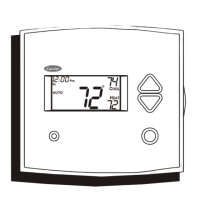


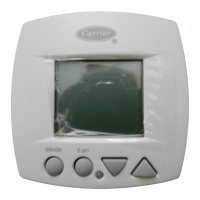
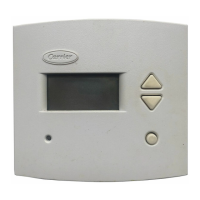

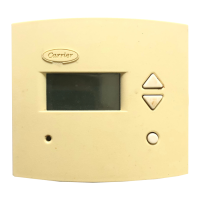
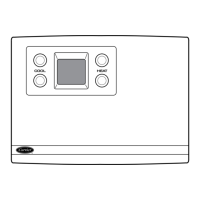


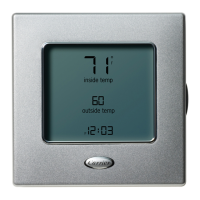
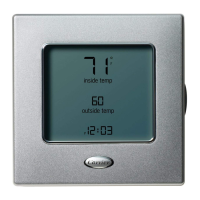
